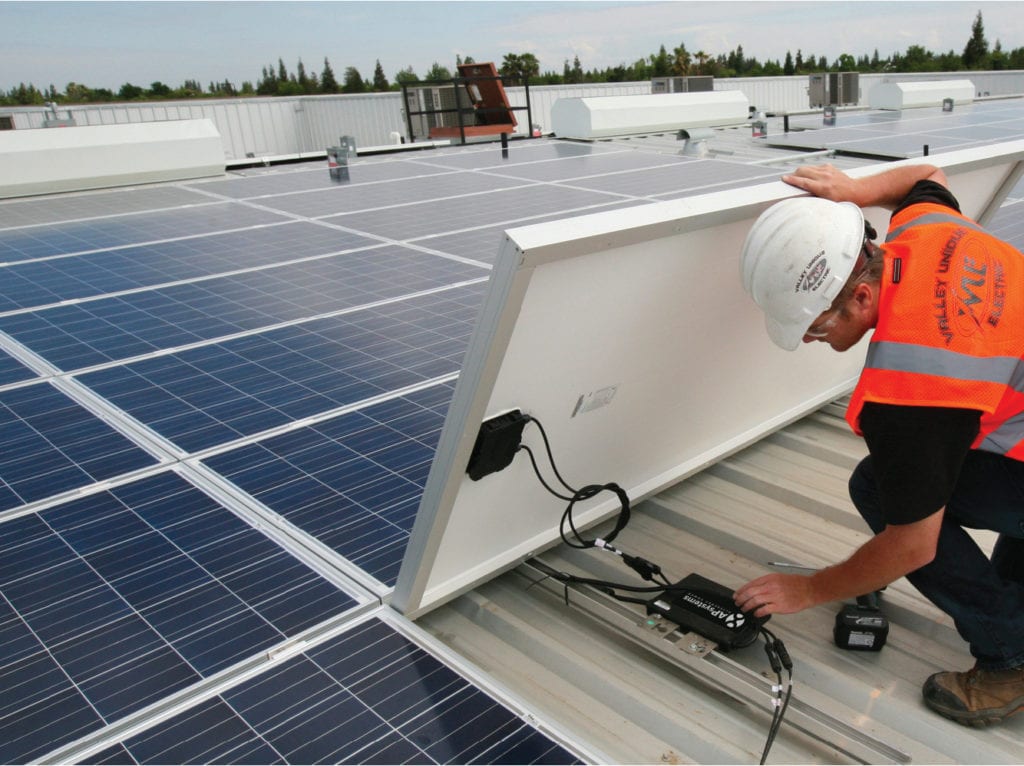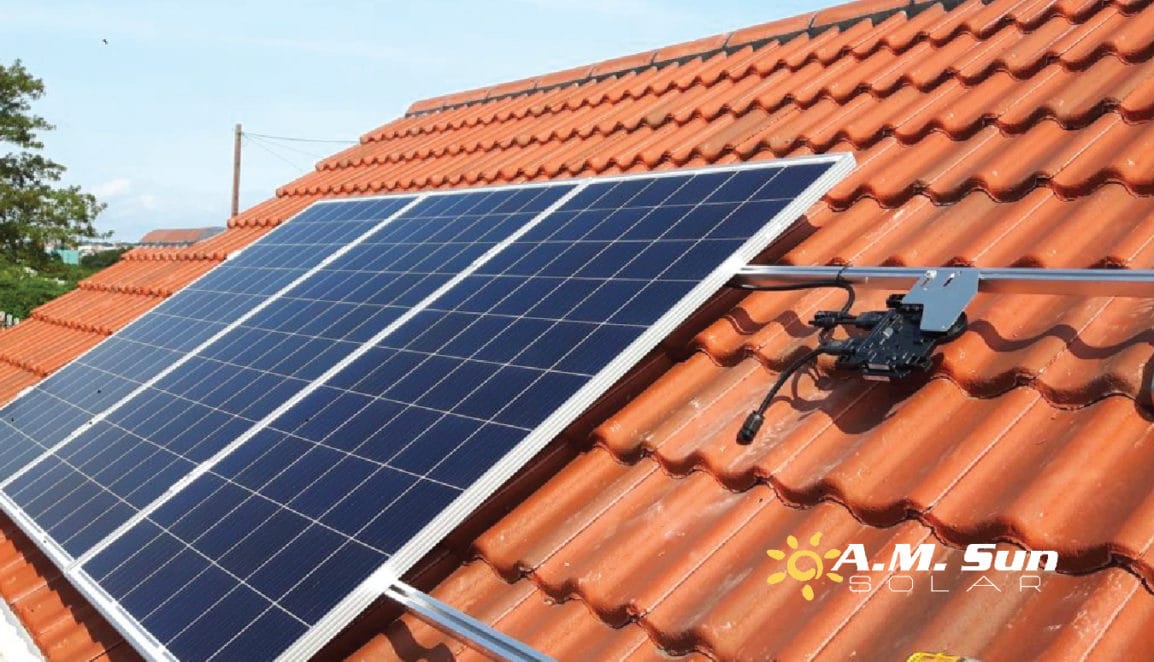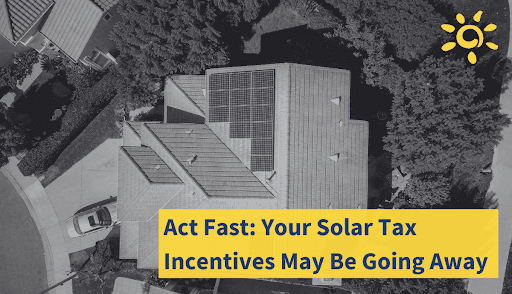Solar panels are made of several different components, one of the most important and complex being the inverter. Solar inverters are responsible for converting the direct current (DC) energy harvested from sunlight into alternating current (AC) so that this electricity can be used by appliances and devices in your home.
As solar technology continues to evolve, so too has inverter technology and capability. Today, two main types of inverters are offered: string inverters and microinverters. It’s important to understand both types of inverters to not only gain insight into the functionality of solar systems but also help you decide which type of system better suits your needs and wants.
String Inverters:

String inverters are also called “central inverters” and consist of a standalone box that is installed close to your home’s main service panel and electricity meter. Typically, you’ll find string inverters in the garage where they’re protected from the elements.
A string inverter functions in a series circuit where there are anywhere from 6-12 solar panels connected in a “series string,” which are then connected to the single inverter where DC gets converted into AC before flowing throughout your home.
There are several advantages and disadvantages to this type of system.
Advantages
- Easy to troubleshoot. While it’s rare that solar systems fail, if anything is going to go awry within the system, it’s likely to be the inverter. Because string inverters are one single unit, it’s easy for a technician to diagnose and fix the issue. Similarly, the easy access a string inverter provides makes it convenient for routine maintenance to be performed.
- Cost. String inverters are cheaper all around. The equipment costs less and they are easier to install, meaning they require less hours of billed labor.
Lower probability of wiring mishap. There are far fewer connections between solar panels and a string inverter as opposed to microinverters. This reduces the chance that the system is improperly cabled, causing functionality issues.
Disadvantages
- Efficiency in partial shade. In a string inverter system, all of the solar panels are wired to the inverter in a series. This means that if one panel’s output is affected, all of the panels are equally as affected. Say one of your panels has some shade on it and is operating at 50% capacity. That means all of the panels in your system are only operating at 50% capacity, regardless of whether they’re fully in sunlight or not. This poses major issues if one or more of your panels are partially shaded for some portion of the day.
- More difficult system expansion. In order for a string inverter to work optimally, it needs to be working near its peak capacity. If at any point you want to expand your solar system, you would have to add in an additional string unit, which incurs additional costs of equipment and labor.
- Shorter lifespan. String inverters are typically warrantied to last 8-12 years, whereas microinverters have a 25-year warranty.
- System monitoring. With a string inverter system you are able to monitor system performance as a whole. But, because there are not specific attachments on each panel, you may miss performance problems caused by cracks, debris, or defects in the panels.
Microinverters:

Microinverters perform the same function as string inverters, but are much smaller and installed on the back of each individual solar panel (although there are some microinverters that also accept two or four panels). Microinverters function in a parallel circuit, which means they are capable of taking full advantage of the production of each individual panel.
Remember the shaded panel example from earlier? In a microinverter system, the only panel that would be operating at 50% capacity would be the partially shaded panel. All other panels would be working at 100% capacity.
There are several additional advantages of microinverter systems.
Advantages
- More electricity. It’s inevitable that at some point clouds, debris, or the tree in your front yard will shade some portion of your solar panels. Because the microinverter system is able to harness energy from each solar panel individually, you get more energy when things like this happen.. With a microinverter system, each panel can produce a different amount of electricity instead of a string inverter system that caps out production with the output of the least productive panel.
- Suitability for challenging installation conditions. Microinverters are best used where the set up of your panels requires them to be at odd angles or if you have shading issues. Although some panels will be producing less than others throughout the day, there is no loss of energy.
- Lifespan. As mentioned earlier, microinverters have a warranty of up to 25 years which is double the lifespan of a string inverter.
- Panel-level monitoring. Because microinverters are attached to each panel, you can monitor the productivity of each individual panel. This also makes it easy to locate and diagnose a potential problem if output is low in one or more panels. With a string inverter system, you can only see the output of the system as a whole, making diagnostic checks like this much more difficult.
System expansion ease. If you ever want to expand your solar system, doing so with a microinverter system is extremely easy.
Disadvantages
- Cost. One of the main disadvantages of microinverters is the cost. They are typically $1,000 or more than string inverters. Because of this, they are usually only recommended if you have a unique solar installation or shading issues.
- Maintenance. Because microinverters are on the roof under your panels, doing any sort of maintenance or troubleshooting requires labor that can prove significantly more costly than maintenance on a string inverter.
- Amount of hardware on your roof. With a microinverter system, you end up with a lot of very expensive hardware on your roof, exposed to the elements. In addition, there is evidence that microinverters can act as miniature lightning rods, so homes in stormy areas with wooden roofs could be prone to additional fire hazards.
Chat with one of our experts today to discuss the pros and cons of each system. Our solar experts will carefully examine your needs and circumstances to help you make the most informed decision.
If you’re ready to make the switch, fill out the form below to schedule an in-home solar consultation with one of our consultants!


